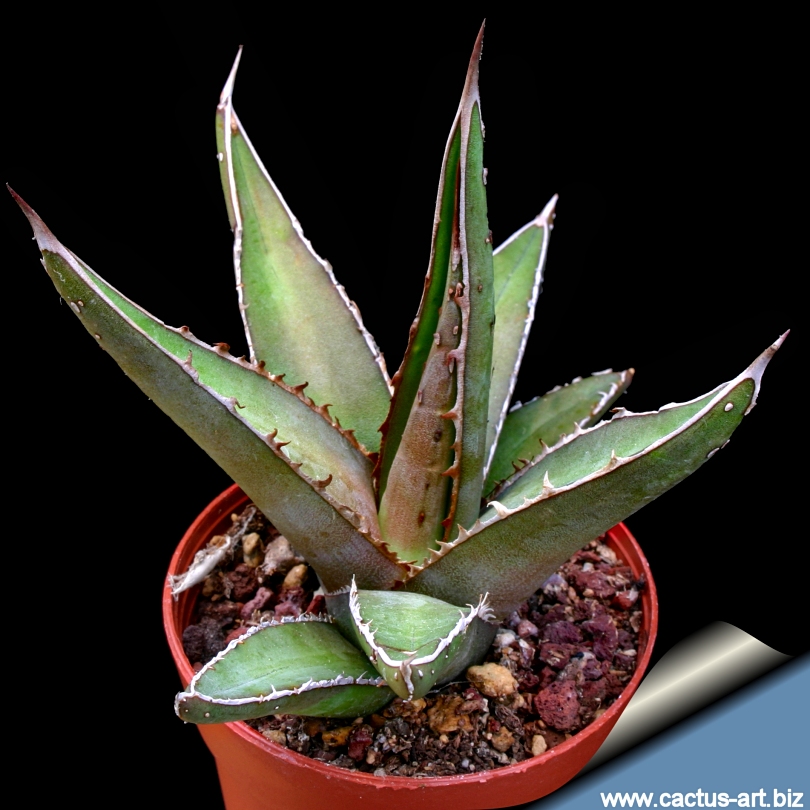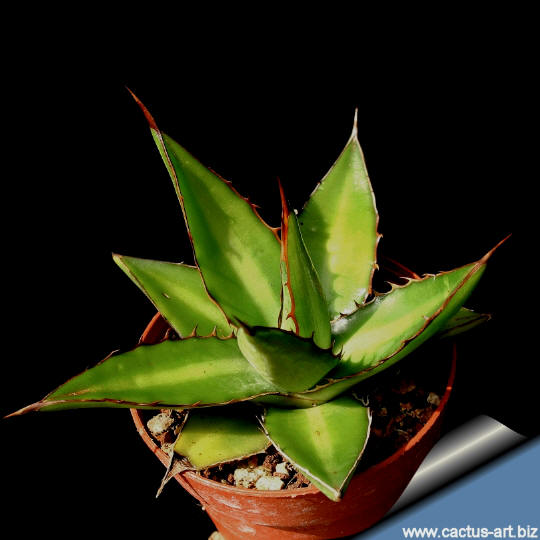|
|
|

A. triangularis (Locality Teuhacan, Puebla, Mexico)
This species make great landscaping items, as well as excellent
potted plants.
|
|
|
Description: Up to
50-80(-100) cm. Slow-growing, short-stemmed, widely surculose, seldom
flowering, rigid rosettes, forming open clones; When this agave matures,
its leaves are stout, and clustered together, creating a starburst
effect.
Leaves: Olive-green, light yellowish green or bright apple-green
or finely flecked with brownish red, finely asperous with a broad
yellowish band running down the center of each leaf., mature leaves
deltoid-lanceolate (dagger-shaped) 30-60 x 5-7 (mid-leaf) cm, rigid,
thick at base, concavo-convex, straight, When stressed by drought and
cool weather, the leaves turn shades of red. Leaves are variable in size
and shape.
Margin: Corneous continuous, 1-2 mm wide, grayish, straight, with
or without teeth, the teeth small, few (2-3 mm long), and remote (3-5 cm
apart), or large, 5-9 mm long, 1-2 cm apart, gray, straight or curved;
Terminal spine: 2-4 cm cm long, conical to subulate, usually
straight, grayish, grooved above, somewhat keeled below
This taxon is recognizable by its thick, rigid, deltoid, olivaceous
leaves. Toothless forms are also common. The leaves of this species are
quite variable depending on clones
Propagation: By
suckers which often are found growing around the base of the
plant, Remove the basal suckers (if available) in spring or summer
and let the cuttings dry for a few days before inserting in compost or
by seed.
|
|


Advertising
|
|
|
|
|
Family: Agavaceae
Subgenus: Littaea (inflorescence in
form of raceme)
Group: Marginatae
Scientific Name: Agave triangularis Jacobi
Published in: Zweiter Nachtrag, zu dem Versuch einer
systematischen Ordnung der Agaveen 149, 1869.
Neotype: Gentry 23399, DES, MEXU, US. 6 miles SW of Tehuacan,
Puebla, along road to Huajuapan, 11 March 1974; elev. 5,750 feet, on
sedimentaries.
Common Names include: Century
plant, American aloe
Origin: Mexico (Puebla, Oaxaca)
Habitat:
Common on the arid calcareous mesa west of Tehuacan in southern
Puebla, in heavily grazed areas with stony ground and tree forms of
Yucca periculosa and Lysiloma sp. Here also are numerous tree cactus and
several other agaves. This table land is 1650 to 1950 m elevation with
475-500 mm of rain, annual .The winters are dry and frostless.
|
Synonyms:
- Agave hanburyi Baker (1892)
- Agave horrida var. triangularis (Jacobi)
Baker
- Agave kerkhovei Hort. ex Jacobi
- Agave regelliana Hort. ex Jacobi
- Agave rigidissima Jacobi (1869)
- Agave triangularis var. rigidissima
(Jacobi) Trelease (1920)
- Agave triangularis var. subintegra
Trelease (1920)
- Agave triangularis Jacobi,
- Agave hanburyi Baker, Kew Bull.
1892: 3, 1892.a
|
|
|
|

|
|
Cultivation: Agave
triangularis is a relatively easy-to-grow species. Need a very
well-drained, soil. It is theoretically hardy to -7° C ,
particularly when dry . It grows fairly
fast in summer if provided with copious water but allows to dry
thoroughly before watering again. During the winter months, one should
only water enough to keep the leaves from shrivelling. They do well in
full sun or a lightly shaded area. Plants cultivated outdoors are
drought tolerant and takes blasting heat and full sun.
|
|